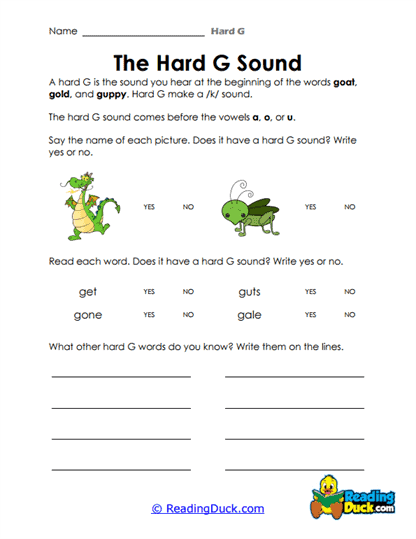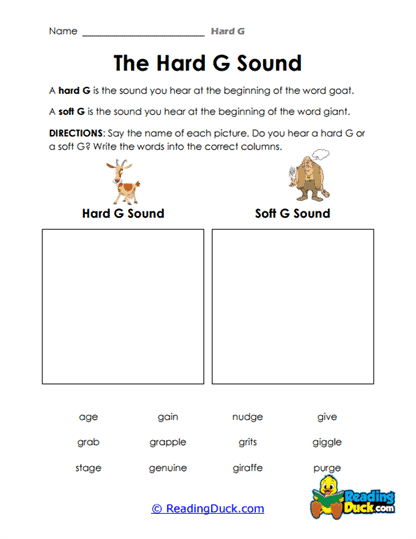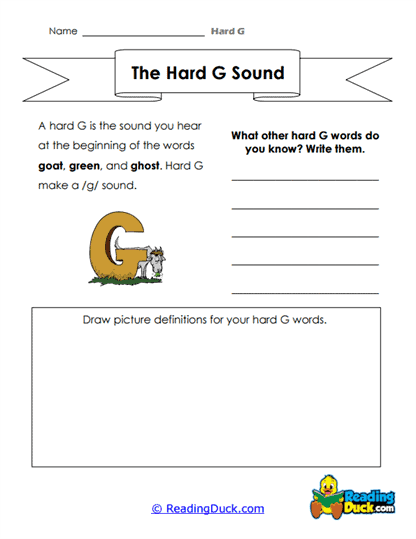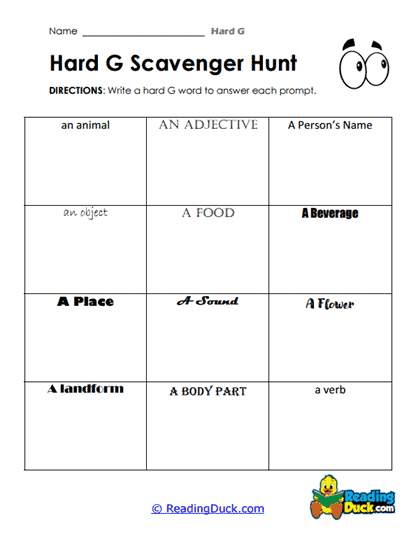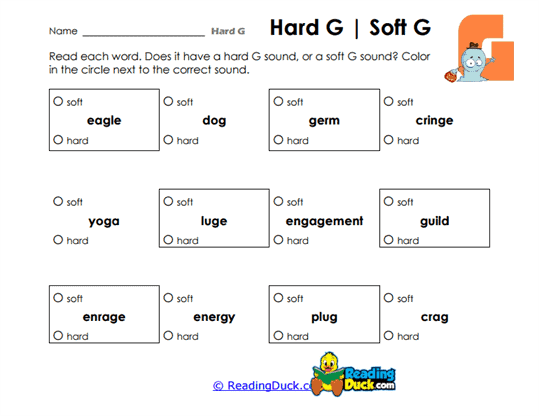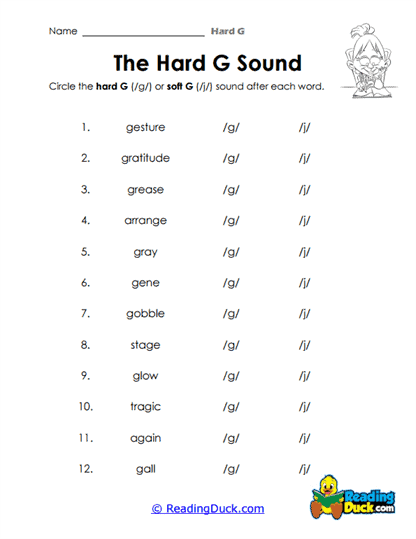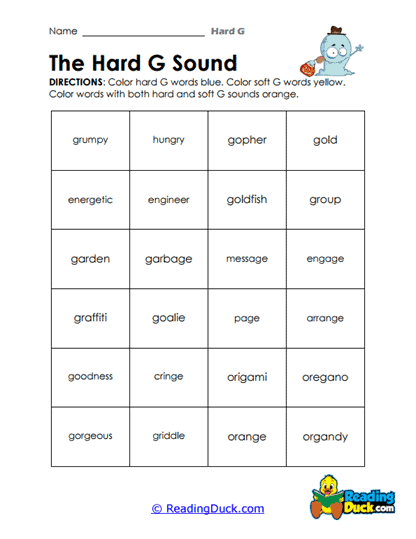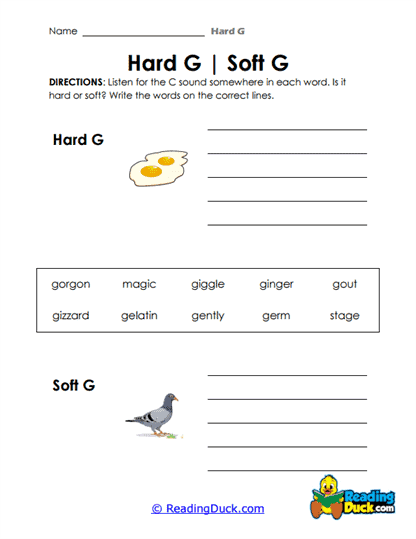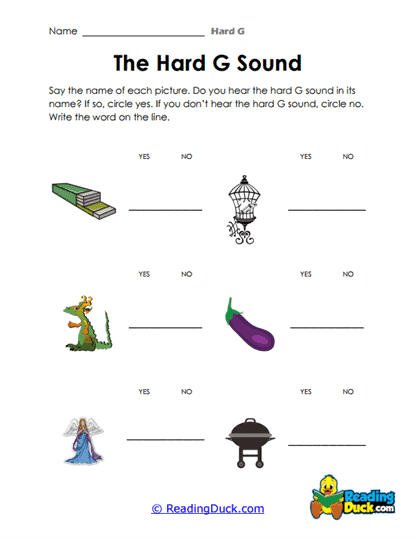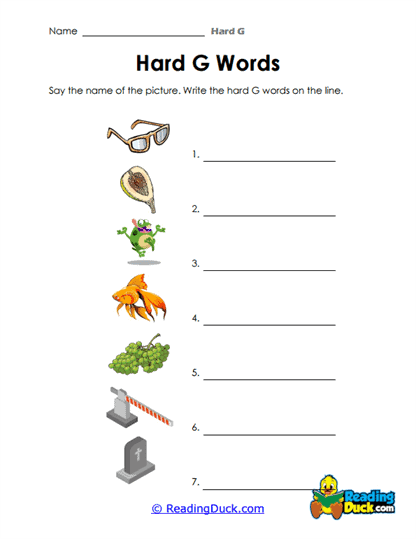Hard G Worksheets
About Our Hard G Worksheets
Our collection of Hard G Worksheets is an essential tool in the 'Phonics' category within the 'Pre-Reading' section, specifically created to help young learners understand and master the sound of the hard "G." These worksheets are designed to teach students how to recognize, pronounce, and spell words that start with or include the hard "G" sound, which is a crucial component of early literacy.
The worksheets are available in PDF format, making them easy to view, download, and print, providing flexibility for both classroom and homeschool use. Additionally, each worksheet includes a downloadable answer key, allowing educators and parents to guide students effectively through their learning journey and easily assess their progress.
Understanding the Hard G Sound and Its Importance in Early Literacy Development
The hard "G" sound is a fundamental aspect of phonics instruction, playing a significant role in the development of reading and spelling skills. As a professional licensed teacher specializing in pre-reading skills, it’s important to explore what the hard "G" sound is, why it matters, and how it contributes to a child's overall literacy growth.
What Is the Hard G Sound?
- Definition: The hard "G" sound is the /g/ sound made by the letter "G" when it is followed by the vowels "a," "o," or "u," or when it appears before a consonant. Examples of words with the hard "G" sound include "goat," "game," and "gum."
- Contrast with Soft G: Unlike the soft "G" (which sounds like /j/ in words like "giant" or "giraffe"), the hard "G" produces a strong /g/ sound. This distinction is important for young learners to understand in order to read and spell words correctly.
The Role of the Hard G Sound in Literacy:
- Phonemic Awareness: Mastery of the hard "G" sound is crucial for developing phonemic awareness—the ability to hear, identify, and manipulate individual sounds in words. This skill is foundational for reading and spelling success.
- Decoding Skills: Recognizing the hard "G" sound helps children decode words more effectively, enabling them to sound out unfamiliar words with greater ease. This is a key step in becoming a fluent reader.
- Spelling Precision: Understanding when "G" produces the /g/ sound aids in spelling accuracy. It helps students distinguish between words with similar spellings but different sounds, improving their overall spelling skills.
- Word Recognition: Familiarity with the hard "G" sound enhances a child’s ability to recognize and read a broader range of words, which is essential for expanding their vocabulary and improving reading comprehension.
Examples of the Hard G Sound in Context:
- "Garden": In the word "garden," the "G" at the beginning makes the hard /g/ sound, which is straightforward for young learners to recognize and pronounce. Understanding this helps students decode and spell similar words like "gate" and "goal."
- "Frog": The word "frog" contains the hard "G" sound at the end, demonstrating how this sound can appear in different positions within a word. Recognizing this pattern aids in reading fluency and word recognition.
How These Worksheets Support the Learning and Practice of the Hard G Sound
Our Hard G Worksheets are carefully designed to assist young learners in recognizing, understanding, and practicing the hard "G" sound in various contexts. These worksheets are a vital part of a comprehensive phonics program, supporting students as they develop their reading and spelling skills.
Focused Phonics Practice:
- Emphasis on the Hard G Sound: The worksheets are structured to focus specifically on the hard "G" sound, helping students zero in on this particular phonics element. This concentrated practice ensures that learners develop a strong understanding of when and how the hard "G" sound is used in words.
- Reinforcement of Phonics Rules: By consistently practicing words that include the hard "G" sound, students reinforce their understanding of the phonics rules that govern its usage. This reinforcement is essential for helping students apply these rules when reading and spelling new words.
- Enhancing Decoding Abilities: The worksheets provide numerous opportunities for students to decode words with the hard "G" sound, strengthening their ability to sound out and read words accurately. This is a critical component of developing reading fluency and confidence.
Supporting Independent Learning:
- Self-Paced Practice: The worksheets are designed to be used independently, allowing students to work at their own pace. This is particularly beneficial in both classroom and homeschool settings, where students may be at different stages of phonics proficiency.
- Visual and Auditory Reinforcement: The worksheets incorporate visual aids, such as images of objects that begin with the hard "G" sound, to help students make connections between the sound and the letter. Auditory reinforcement, such as practicing saying the words aloud, further supports the learning experience.
Strategies for Teaching the Hard G Sound Effectively
Teaching the hard "G" sound requires a thoughtful and systematic approach to ensure that young learners grasp the concept and can apply it confidently in their reading and writing. Here are some strategies that educators can use to introduce and teach the hard "G" sound effectively:
Introducing the Hard G Sound:
- Start with Familiar Words: Begin by introducing the hard "G" sound using simple, familiar words such as "goat," "gum," and "gift." These words provide clear and relatable examples of the sound in context.
- Use Visual Aids: Incorporate visual aids such as flashcards, word charts, or digital tools that highlight the hard "G" sound in different words. Visuals help students associate the /g/ sound with the letter "G" and recognize it in various words.
- Modeling and Guided Practice: Demonstrate how to pronounce the hard "G" sound by breaking down words into their individual sounds. For example, say "game" slowly, emphasizing the /g/ sound at the beginning. Guided practice with the whole class or in small groups helps reinforce the concept.
Helping Students Master the Hard G Sound:
- Interactive Reading Sessions: Include books or passages that contain words with the hard "G" sound in your reading sessions. Pause to highlight these words and discuss the sound with students, reinforcing their understanding in a meaningful context.
- Consistent Practice: Ensure that students have ample opportunities to practice reading and spelling words with the hard "G" sound. Repetition and consistent practice are key to mastery, so incorporate these words into daily phonics lessons and reading activities.
- Word Exploration: Encourage students to find and share examples of words with the hard "G" sound in their reading materials. This exploration not only reinforces their understanding but also builds their confidence in applying phonics rules independently.
Practical Tips for Using Hard G Worksheets Effectively
To maximize the effectiveness of the Hard G Worksheets, educators and parents can use the following practical tips to ensure that young learners thoroughly understand the concept and can apply it confidently.
Incorporating Worksheets into Daily Lessons:
- Morning Phonics Practice: Use the worksheets as part of a morning phonics practice routine. This helps students start the day with a focus on reinforcing the hard "G" sound, setting a strong foundation for the rest of their literacy activities.
- Homework Assignments: Assign worksheets as homework to provide additional practice. Encourage parents to review the hard "G" sound with their children, reinforcing what was taught in class and helping to solidify the lesson.
- Small Group Work: Utilize the worksheets during small group work for targeted phonics practice. This setting allows for more personalized instruction and gives students the opportunity to ask questions and receive immediate feedback.
Supplementary Activities to Support Learning:
- Sound Sorting Games: Create sound-sorting games where students categorize words based on whether they start with a hard "G" sound or another consonant sound. This helps them differentiate between sounds and reinforces their understanding of the hard "G."
- Interactive Phonics Activities: Incorporate interactive phonics activities, such as bingo or matching games, that focus on words with the hard "G" sound. These activities make learning engaging and enjoyable while providing valuable practice.
- Story Creation: Encourage students to create their own short stories or sentences using words that contain the hard "G" sound. This creative exercise not only reinforces the phonics concept but also enhances their writing and storytelling skills.
Cultivating Literacy Skills with Hard G Worksheets
In conclusion, our Hard G Worksheets within the 'Phonics' category of the 'Pre-Reading' section are a crucial resource for helping young learners develop a strong foundation in phonics, particularly in recognizing and applying the hard "G" sound. These worksheets are designed to build essential reading and spelling skills, empowering students to become more confident and proficient readers.
The mastery of the hard "G" sound goes beyond just phonics instruction; it equips students with the tools they need to decode and understand a wide range of words, which is vital for their overall literacy development. As students practice and internalize the hard "G" sound, they will become more adept at reading and spelling, leading to greater academic success.
Educators and parents can use these worksheets to create an engaging and supportive learning environment that fosters both independent practice and guided instruction. By integrating these worksheets into daily lessons and supplementing them with interactive activities, students will not only master the hard "G" sound but also develop a love for reading that will serve them throughout their educational journey.
These worksheets are especially well-suited for kindergarten through second-grade learners, making them an indispensable part of any early literacy curriculum. They ensure that young readers gain the phonics skills and confidence they need to thrive in their reading and writing endeavors, laying the groundwork for continued success in all areas of learning.
